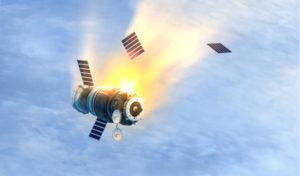 A report has found both Russia and China are racing to develop technology capable of jamming or destroying U.S. military and commercial satellites. The report, “The Worldwide Threat Assessment” by Daniel Coats, Director of National Intelligence, goes on to say that the “Russian and Chinese destructive anti-satellite (ASAT) weapons probably will reach initial operational capability in the next few years.”
A report has found both Russia and China are racing to develop technology capable of jamming or destroying U.S. military and commercial satellites. The report, “The Worldwide Threat Assessment” by Daniel Coats, Director of National Intelligence, goes on to say that the “Russian and Chinese destructive anti-satellite (ASAT) weapons probably will reach initial operational capability in the next few years.”
Continued global space industry expansion will further extend space-enabled capabilities and space situational awareness to nation-state, nonstate, and commercial space actors in the coming years, enabled by the increased availability of technology, private-sector investment, and growing international partnerships for shared production and operation. All actors will increasingly have access to space-derived information services, such as imagery, weather, communications, and positioning, navigation, and timing for intelligence, military, scientific, or business purposes. Foreign countries—particularly China and Russia—will continue to expand their space-based reconnaissance, communications, and navigation systems in terms of the numbers of satellites, the breadth of their capability, and the applications for use.
Both Russia and China continue to pursue antisatellite (ASAT) weapons as a means to reduce US and allied military effectiveness. Russia and China aim to have nondestructive and destructive counterspace weapons available for use during a potential future conflict. We assess that, if a future conflict were to occur involving Russia or China, either country would justify attacks against US and allied satellites as necessary to offset any perceived US military advantage derived from military, civil, or commercial space systems. Military reforms in both countries in the past few years indicate an increased focus on establishing operational forces designed to integrate attacks against space systems and services with military operations in other domains.
Russian and Chinese destructive ASAT weapons probably will reach initial operational capability in the next few years. China’s PLA has formed military units and begun initial operational training with counterspace capabilities that it has been developing, such as ground-launched ASAT missiles. Russia probably has a similar class of system in development. Both countries are also advancing directed-energy weapons technologies for the purpose of fielding ASAT weapons that could blind or damage sensitive space-based optical sensors, such as those used for remote sensing or missile defense.
Of particular concern, Russia and China continue to launch “experimental” satellites that conduct sophisticated on-orbit activities, at least some of which are intended to advance counterspace capabilities. Some technologies with peaceful applications—such as satellite inspection, refueling, and repair—can also be used against adversary spacecraft. Russia and China continue to publicly and diplomatically promote international agreements on the nonweaponization of space and “no first placement” of weapons in space. However, many classes of weapons would not be addressed by such proposals, allowing them to continue their pursuit of space warfare capabilities while publicly maintaining that space must be a peaceful domain.
Source: Worldwide Threat Assessment of the US Intelligence Community
E.J. Smith - Your Survival Guy
Latest posts by E.J. Smith - Your Survival Guy (see all)
- Yes, Money Can Buy You Happiness - April 23, 2024
- State Income Taxes and the 2024 NFL Draft Class - April 23, 2024
- This ARK is Sinking - April 23, 2024
- “That’s Why I Hired You,” They Tell Me - April 22, 2024
- The Silver Lining of Higher Interest Rates - April 22, 2024















